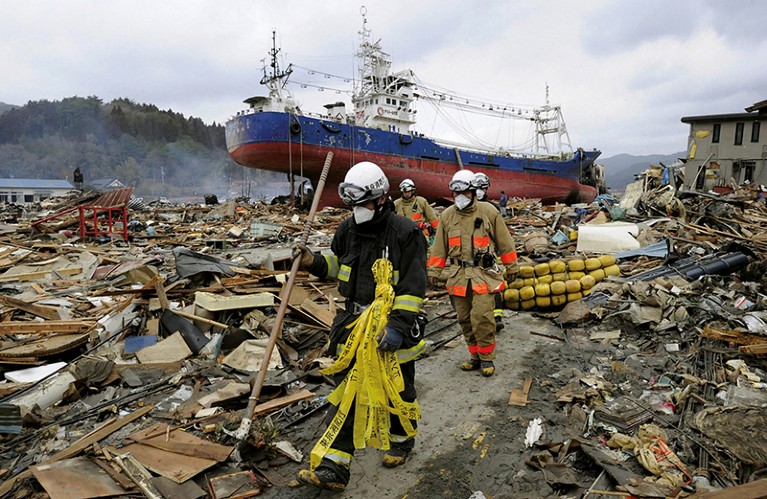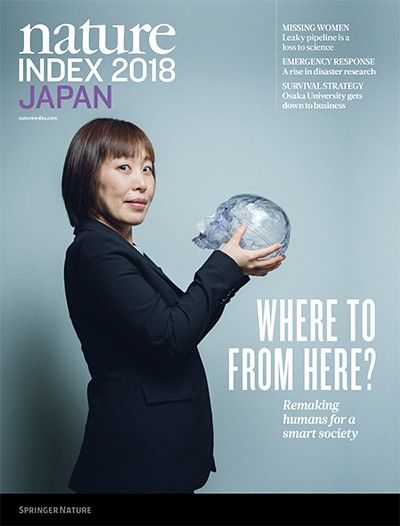
Emergency workers in Kesennuma, northeastern Japan, in the wake of the earthquake and tsunami of March 2011. Close attention is paid to research into forecasting natural disasters.Credit: Newscom/Alamy
Volcanic eruptions, typhoons, floods, mudslides, fires and earthquakes are commonplace in Japan. Disaster research is a national priority for good reason.
The National Research Institute for Earth Science and Disaster Resilience (NIED) is Japan’s best performing government institution when assessed on its authorship of papers in the index relative to its total output in the Scopus database of natural science publications. Between 2012 and 2017, it contributed to a weighted fractional count of 22 in the index, from 304 Scopus papers in the natural sciences.
NIED was established in 1963, a few years after the Ise Bay Typhoon that killed more than 5,000 people. In 2015, it specified its mission to pursue research that will “increase the level of science and technology for disaster risk reduction” and build disaster resilience. NIED promotes research for all hazards in all phases, says its president, Haruo Hayashi. Researchers in the natural sciences, engineering and social sciences are studying better ways to predict, prevent and respond to calamities of all types, he says.
With headquarters in Tsukuba, northeast of Tokyo, NIED has a staff of about 250, and an annual budget of 9.2 billion yen (US$81.6 million), down from 11 billion yen in 2008. Its labs across the country include the Shinjo Cryospheric Environment Laboratory in Yamagata Prefecture, the Snow and Ice Research Center in Niigata and in Miki City, and the Hyogo Earthquake Engineering Research Center, which hosts the world’s largest earthquake simulator, or ‘shaking table’, known as E-Defense.
NIED maintains a nationwide seismographic network of more than 2,000 stations for quake monitoring. It has recently installed a 5,500 kilometre fibre-optic network along the ocean floor, connected to 150 observation stations, intended to predict tsunamis off Japan’s eastern coast.
NIED researchers’ publications reveal the diversity of its work. A 2015 Nature letter by NIED geophysicist, Futoshi Yamashita, and colleagues looked at the relationship between earthquakes and the frictional properties of rocks. Experiments on samples suggested that natural faults weaken an order of magnitude faster than had been previously estimated.
In October 2017, an issue of the Journal of Disaster Research was dedicated to NIED’s work. The papers covered topics such as undersea seismic velocity around Japan, the use of virtual reality to simulate damage from earthquakes, and how information was gathered and shared in the aftermath of the quakes that hit Japan’s Kumamoto Prefecture in 2016.
In a September 2016 evaluation, Japan’s science ministry praised NIED for its insights and information-sharing following the Kumamoto disaster, which killed dozens and injured thousands. It also recognized the 1.54 million hours of testing conducted using the E-Defense system. E-Defense has become an essential tool for ensuring the safety of structural designs, says Masayoshi Nakashima, former director of the operation currently at Kyoto University. But, NIED has its critics too. Seismologist, Robert Geller, professor emeritus at the University of Tokyo, has been critical of Japanese efforts to forecast earthquakes “because of the dodgy nature of the underlying science.” He says NIED’s network of observatories provides essential data for seismologists but the network’s funding “should be continued based on its own merits, rather than the pretence that it’s needed to forecast earthquakes”.


 Stalled ambition
Stalled ambition
 Resistance to reform
Resistance to reform
 Relative gain
Relative gain
 Calling rikejo
Calling rikejo
 Partners in discovery
Partners in discovery
 Strength from weakness
Strength from weakness
 Pillars of a smart society
Pillars of a smart society
 Short-term generation
Short-term generation
 Access granted
Access granted
 Noble halls of discovery
Noble halls of discovery
 A guide to the Nature Index
A guide to the Nature Index







